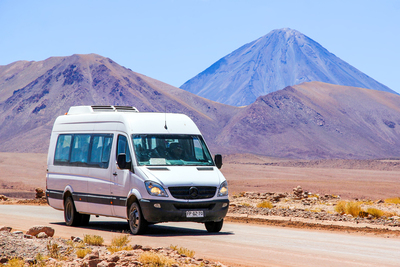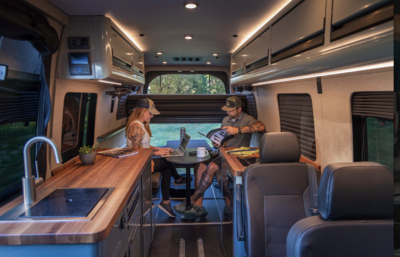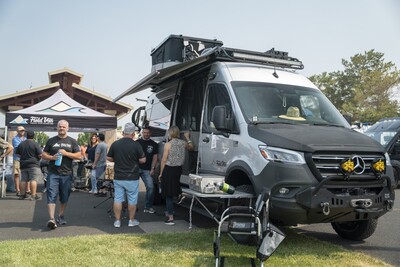By Douglas McColloch
It’s no secret that overlanding has been one of the fastest-growing segments in the automotive aftermarket, and as it has gained popularity over time, the market has diversified. This can be seen in the types of vehicles employed as build platforms. Once dominated by midsize Toyotas, the overlanding segment has grown to include Jeeps and, increasingly, fullsize HD pickups with their superior load-carrying capability.

A new player in the overlanding segment, adventure vans can be built for any use, whether it’s easy pavement travel or more strenuous off-road activity. Photo credit: Shutterstock.com
Now, yet another vehicle type has entered the sector, and it has ushered a new generation of backcountry enthusiasts into the pastime of overlanding. Known alternatively as adventure vans, camper vans or, occasionally, “glamper” vans, these vehicles represent a fast-growing segment of the overlanding market and offer a potential new revenue stream for aftermarket outfitters looking to partner with existing van builders, for established coach builders looking to diversify their product lineups, or for startups looking to capitalize on new opportunities in a fresh market.
For the purposes of this article, vehicles referred to as “adventure vans” generally fall into the category of Class B motorhomes. They are smaller in size—typically 17–23 ft. in length—and generally less luxuriously apportioned than the more expansive Class A and C motorhomes manufactured by companies such as Winnebago and Thor Motor Coach. Also, unlike their larger counterparts, they utilize existing OE light-truck chassis and bodywork, making them a more attractive alternative for consumers on a budget. They’re also more economical to own, thanks to better fuel economy, and their smaller size makes them easier to maneuver and park.
In the North American market, the preferred platforms for these vehicles are typically 1-ton Ford Transit, RAM Pro Master or, most commonly, Mercedes Sprinter chassis, all offering all-wheel drive as the standard drive configuration, and base prices for these vehicles in stock (unmodified) trim start in the $45,000 range. Fully equipped, an outback-ready unit can list for six figures, so this segment represents a potentially lucrative source of income for businesses in the specialty-equipment market.
The State of The Market
Whatever their classification, RV sales are at an all-time high. According to a 2021 manufacturer survey conducted by the RV Industry Association, an industry record 600,240 wholesale shipments were recorded in 2021, an increase of nearly 20% since 2017. At present, the adventure van segment alone represents a $16.8 billion global market, a figure that is forecast to reach $24.8 billion by 2027, according to a 2022 survey from Marketwatch.
“The adventure van market continues to grow rapidly,” said Scott Brady, publisher of Overland Journal, “but the primary markers of success are differentiating features, unique manufacturing processes, or improvements to backcountry performance. Van builders that are creating a unique offering or a performance advantage are continuing to garner long lead-times and full production schedules.”
“The market has seen rapid growth over the recent five years, with new builders coming online almost every month,” said Eric Miller, co-funder of TouRig, a Colorado-based van conversion company. “We’re seeing new accessory companies introducing new product innovations that are directly catered towards the Adventure Van consumer. We are also seeing very nice cross-pollination with the outdoor industry, something that for years was somewhat a controversial subject.”
“It’s my understanding that Class Bs are the fastest-growing segment of the RV market,” said Neil Morse, owner/promoter of the nationwide Adventure Van Expo series. “We still have tons of new people coming to our shows that have never seen them.”
“It’s a market that’s really been growing the last few years here,” said Oliver Bahr, president for the Americas with Dometic, a manufacturer of products for the adventure-lifestyle market. “The van market has really been growing well for us.”
How well? “When we entered the market in 2014, there were somewhere around 10 to 12 real players in the space, excluding the behemoth RV brands,” Miller recalled. “Today, there could be as many as 150-plus builders contributing to the adventure van space.”

Besides having the capability to transport their owners to remote areas, adventure vans can also offer all the comforts of home—it all depends on what buyers want, and the size of their budget. Photo courtesy: Tourig
Who They Are
According to our experts, adventure van owners tend to differ from conventional RV owners by their desire to travel further afield than what’s allowed by a bigger, bulkier Class A motorhome. “All-wheel-drive vans allow access to more remote campsites, hiking trails and similar points of interest,” said Brady. “Adventure vans tend to correlate with hikers, mountain bikers and outdoor photographers.”
“It’s usually an active couple or family,” Morse said, with varied outdoor interests: “Biking, skiing, paddle boarding, surfing and the like.” Miller concurred: “Our biggest demographic is the outdoor enthusiast with a strong passion for outdoor recreation such as fishing, hunting, biking, skiing, etc.”
Despite a sometimes-steep price of entry, the segment exerts a strong appeal on younger consumers. “We get customers in their 20s, but more frequently they’re people in their 30s who’ve been working an office job for 10 years, and now they just want to travel,” said Duran Morley, founder and CEO of The Van Mart, a California-based van conversion company.
As a rule, though, the typical adventure van consumer base skews somewhat older. “We generally see a middle-aged consumer with an adventurous spirit looking to enhance their journey through travel,” said Miller. “This new category has made the journey as much fun as the destination.”
What They Buy
Overlanders have higher-than-average levels of disposable income (see “Backcountry Business Tips,” SEMA News October 2022), and players in the adventure van segment can benefit from an enthusiast customer base that’s willing to spend plenty of money to customize their vehicles to their exact liking.
“The segment’s growth is focused around accessories that improve the capability and appearance of the vans,” said Brady. “Lift kits, bumpers, racks and even snorkels abound.” Miller agreed, mentioning upgraded suspension packages, larger wheel/tire combinations, rear tire carriers, rear storage boxes, roof racks and ladders as popular items.
Morse similarly pointed to tires and wheels along with “anything battery-powered” such as cellphone boosters, and Bahr mentioned products that offer “modularity—being able to take that freezer, refrigerator or a cooktop from the inside to the outside of the van.”
Most of our experts agreed that price is secondary in importance to quality for most adventure van owners, so manufacturers of higher-end componentry can find opportunities for growth. “People are willing to pay for the quality, and they want to make sure that they have the right product for when they’re off grid,” Bahr noted. “They don’t want to be in a difficult position out in the wild.”

A multi-event series that takes place at various locations throughout the United States, Adventure Van Expo attracts hundreds of enthusiasts as well as vendors and manufacturers of outdoor lifestyle products. Photo courtesy: Adventure Van Expo
COVID and Campervans
All of our sources agreed that the outbreak of COVID-19 in 2020 turbocharged growth in the market as locked-down consumers with extra time on their hands looked for recreational opportunities away from crowded spaces. The pandemic “sent [business] through the roof!,” Morse exclaimed.
This surge in popularity has shown no signs of slowing down. Attendance at Adventure Van Expo was “double in 2021 over the previous year, and another 25% higher in 2022,” Morse said.
While COVID played a part, Brady also noted that growth “began with the availability of the AWD Mercedes Sprinter,” while adding a caveat. “As return to work has increased and financing has become more expensive, we have seen some reduction in growth. In particular, the standard van builders are seeing a reduction in order rates. However, the vans with more bespoke interiors or improved capability are still performing well.”
Social Distancing and Social Media
Adventure travelers often utilize social media to share their travel experiences with others, and our panel of experts recommended maintaining a robust social presence to optimize consumer outreach.
“People enjoy a sense of community, and they like to share within that community,” Bahr said. “We have a distinct set of users in this side of the business, where they like to share their ideas, they like to share their experiences, they like to show what they’ve done, what they’ve built and what they’re using. So engaging with that community is a really critical aspect for a brand like us.”
Future Challenges and Opportunities
While our experts were optimistic for the near-term future, some expressed concerns about a slowing economy. Morse had an eye out for the consequences of the Federal Reserve’s recent inflation-fighting measures given their affect on financing costs. “A rise in interest rates may take some players out of the van market,” he said.
Still, most of our experts agreed that the smaller Class-B platform would prove resilient in the face of competition from the bigger vehicle classes. “It’s still headed favorably in our direction,” Morse said. “We have a very economical and maneuverable platform with the diesel Sprinter. For couples, you can’t beat it. You can get into 19-ft. spaces and still have a bed, bath and shower.”
“The majority of the growth will come from the brand name offerings as they have access to the dealer networks and financing required for volume sales,” Brady said. “The most pressing challenge is chassis availability, with demand for Mercedes AWD Sprinters exceeding allocations. We need more AWD van options from companies like Nissan and RAM.”
As bigger players such as Airstream and Thor bring their own Class-B vans to market, our experts agreed that adventure vans’ public profile only figures to increase in the near term.
“The bigger players are definitely going to make an impact and actually make the industry stronger by having more visibility, driving more traffic and attention to the van market,” Bahr said, adding that “they’ll typically create a standard footprint with maybe two or three floor plans, and try to drive mass volume with that.”
“With the big RV brands starting to market vehicles into this segment, it certainly shows that stockholders are taking note,” Miller added. “As this market segment continues to grow and evolve, we will likely see interesting innovations in space management, lighter material introductions and technology improvements leading to a better consumer experience.
“The pressing challenges are in better regulation and accountability. All the rapid growth the market has seen comes with a more is better mentality which can lead to a lack in quality control. An increase in education creates an elevated experience for the end consumer.”
For the future, Morse pointed to electrification as the next big potential growth driver. “I think we need to work on E-vans sooner than later. If we get them into the 400-mi. range (fully loaded), we will see an explosion in the market.”
Bahr also noted the future movement “towards self-sustaining power, which has been massive, using solar energy to power the battery packs to then power up refrigerators, cooktops and whatever else may be within the van.
“We’re facing some economic headwinds right now, so things are kind of stabilizing a bit temporarily, but we still see a lot of growth potential in this area.”
“I also think we’ll see some of the same supply problems, be they vehicles or materials, that the industry is facing now,” Morse added. “Larger players will take bigger allocations, and the secondary market should see a bump in inventory.”
“There is already a leveling of demand and the beginning of consolidation within the segment,” Brady concluded. “This is typical, and we are watching the players closely. The economy will dictate the next shift.”





